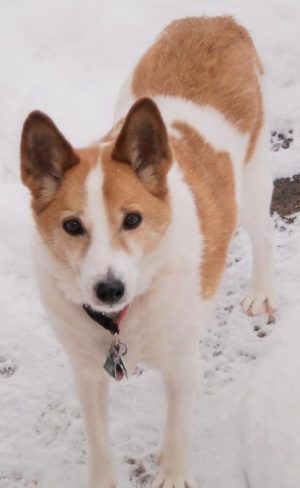
Long before 20th-century modernist architects and industrial designers said that the shape of a building or object should follow its function or purpose, purebred dogs were prime examples of “form following function.” Our pages are filled with various examples, and here’s one more:
For the same reason that athletes smear black grease or a apply a black strip under their eyes to reduce glare, one particular nordic breed has dark eyes and dark “mascara” around the eyes to reduce glare from sunlight reflecting off snow. Upright and highly mobile ears make hunting by sound easier (and often more reliable because scent might be covered by fresh snow), while a flat-lying double coat repels water and insulates against the frigid temperatures found in the countries within the Arctic Circle. Flexibility that allows this dog to extend its front legs sideways with close to a 180-degree spread would be startling enough were it not also for the shoulders that enable legs to reach up and backward behind their heads with their heads held upright. This elasticity found only in one other breed (the Lundehund) allows the dogs of this breed to navigate rough terrain and through heavy bramble easily. By now, some of you may have recognized the description of the Norrbottenspets (pronounced Nor-bow-ten-spets), a small hunting spitz that has lived and survived where only the strongest and most effective individuals could.
Dr. Alvin Grossman and and Beverly Grossman wrote in their article, Form Follows Function, “Your dog was bred for a purpose. The originators of your breed, be it Weimaraner or German Wirehaired Pointer, had in mind certain features that allowed the dog the ability to do what they wanted from him.”
The “Nobb” proves it.
Photo by Nancy Sanchez

So sick of the ‘blank slate’ line of though in dog breeds. BREED MATTERS. Do your research BEFORE you get a dog- you should understand what is was designed to do and IF that is compatible with your lifestyle.
Well said!
Totally true, and with the Norbottenspets, and some of their cousins in the Nordic hunting and herding breeds, barking is part of that job. Form not only follows function, so does behavior. Can some of them have barking that goes beyond the part for the job? Sure, but those breeds come with a bark that will carry across the landscape and through weather to the hunter or shepherd, and they are going to use that bark at times. Squirrels in the backyard? The Nobbs will happily hunt it, barking up a tree, while Icelandic sheepdogs will often give it the treatment they’d give a bird of prey, and bark to drive it off. Can it be managed in non rural settings? Yes, but you’d better start out with a plan rather than try to be doing catch up.
It’s always reassuring to get conformation from folks who know the breed, Karen, so thanks for this!